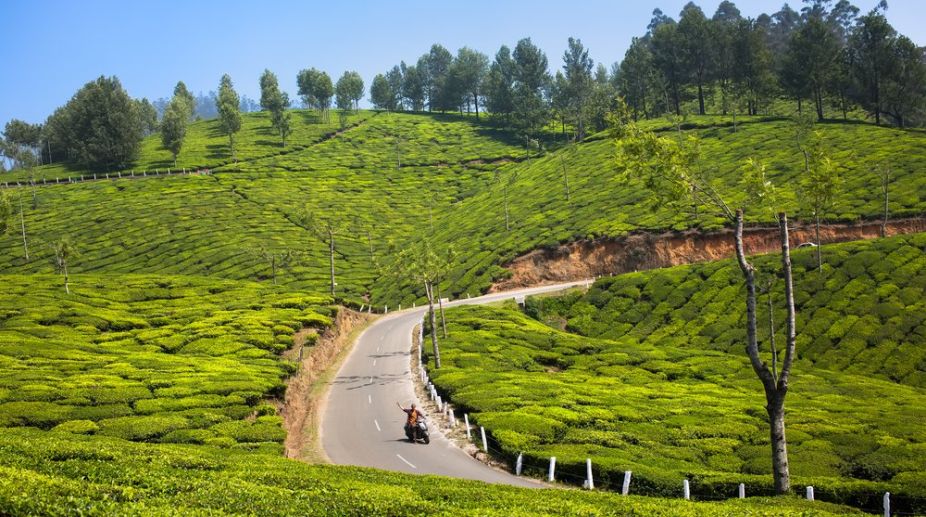Having experienced the charms of Kerala’s backwaters this winter, I wasn’t sure if I was up to another trip to God’s Own Country quite so soon, albeit this time to Munnar. Located in Idukki district, not only is the town a four-and- a-half- hour flight from Delhi (I could’ve reached Thailand in the same time) but is also a good fivehour road journey (around circuitous bends) from the airport. As a traveller vulnerable to motion sickness, the journey sounded daunting.
However, within hours of landing in this bewitchingly beautiful town, all my doubts vaporized like the mist that floats over this region. Nestling within the Western Ghats, Munnar is like, well, Nature on steroids. Hills cloaked in 50 shades of green, plunging valleys, foamy waterfalls, lush forests, exotic flora and fauna and some of the world’s highest tea plantations that stretch like carpets into the horizon….What’s not to like?
Advertisement
However, for me, the magic of Munnar began even before I’d reached the destination. The exciting drive from the airport took me over hill-hugging roads with views of tea estates on one side and majestic mountains on the other. The landscape ~of shifting billowy clouds and clear blue skies ~ changed at every turn, round every bend.
After the long drive, a warm reception awaited me at Club Mahindra Resort, a property inspired by IndoBritish architecture with its cottages overlooking lush tea plantations. Quaffing a refreshing welcome drink of coconut water, and with a garland of cardamom pods around my neck, I checked into my suite overlooking tea gardens and contiguous hills.
In the morning I woke up to the surround sound of twittering birds and fluttering butterflies! I also learnt that the universe I’ll inhabit for the next three days is a healthy and bio-diverse ecosystem that hosts a variety of rare flora and fauna, including the Malabar Hornbill, Paradise Flycatcher, Indian Parakeet, Flying Squirrel, Barking Deer, Bulbul, Monkeys, Hill Maina, Mongoose, Vernal Hacking Parrot, House Crow, Pied Bushchat, Grey Breasted Laughing Thrush, Malabar Whistling Thrush, Spotted Dove and Red Wattled Jawping. Over 50 varieties of indigenous flowering and ornamental plants as well as over 20 varieties of bamboo sprout over the terrain.
After a breakfast of champions ~ fresh juice, continental delicacies as well as South Indian dishes ~ I toured the resort’s organic garden, which grows over 50 varieties of vegetables, fruits and spices. “The crop rotation method of cultivation prevents depletion of natural nutrients and minerals in the soil as well as soil erosion” the resident ecologist tells me. Rare domestic animals ~ including the endangered species of the Vechur cow (its milk has medicinal value), Pygmy goat (the smallest breed of goats) and the rare black hen ~ are also bred here. There’s bee farming too, which produces organic honey.
My three-day itinerary is packed with engaging activities ~ a trek in the tea gardens, a visit to a 19th century tea factory, Ayurvedic massages and a tea tasting session, where an experienced brewer showcases 10 different varieties of teas including black, green and white. “The first step of preparing that perfect cuppa is to ensure that the tea is infused right,” the expert tells us as we stand facing a smorgasbord of tea blends in white porcelain dishes. “To do that, we will use special clay pots, which do not interfere in any way with the flavour and taste of the beverage.”
The tea leaves are infused for exactly five minutes, using an hour glass, with water at the right temperature. Post infusion, the teas are transferred to different cups to ensure that their impurities were drained out. The brewer then demonstrated the right way to taste the tea. “Take a sip of tea and swirl it in the mouth to feel the taste and absorb all the flavours,” he explained as we obey him obediently.
As we moved from one tea to the other, we’re explained the uniqueness of each tea. The green tea had a mild aroma and flavour; the green tea teemed with antioxidants providing high oxidation (thereby rejuvenation) for the body while white tea brimmed with anti-ageing properties and is among the costliest teas in the world. Post the session, we try different infusions with forest honey.
Though Munnar’s economy is powered by tea, the town offers other enchantments too. It is home to Lakkam Waterfalls as well as the wooded Anamudi, peninsular India’s highest peak, at 2695m. The blue-tinged Neelakurinji flower also blooms here once in 12 years carpeting entire swathes of the valley in shades of cyan and purple. We visit the Eravikulam National Park that shelters the endangered mountain goat Nilgiri tahr “Munnar” means three and rivers as it is located at the confluence of the Mudhirapuzha, Nallathanni and Kundaly rivers the guide explains as we wend our way 15 km out of town through stunning panoramas of the Western Ghats to the 160-year-old Lockhart Tea Factory. At the factory, sacks of tea leaves are being offloaded everywhere from lorries by workers in green overalls to be taken for withering. The air was redolent with the smell of bruised tea leaves. The factory produces about 20 million kilograms of tea annually, we were told. We learnt about the processes involved in making modern tea ~ from picking to processing to packaging.
Food was another highlight of the trip. Every meal was a feast of flavours, leveraging Kerala’s reputation as the “Land of Spices”. Spiceinfused Malabari biryani, karimeen pollichathu (steamed fish in plantain leaf), Chemmeen ularthiyathu (prawn roast), kappa (tapioca cake) with meen mulakittthu (a fiery red fish curry), appam (laced pancakes) with stew made my taste buds sing. Fresh catches like black pearl spot, prawns, oysters and squid smelling of the ocean took me to places I’d never been.
Every night, we also got to view an immersive cultural programme, where local artists showcased the state’s centuries-old art forms. If one day it was Kalari Payattu, Kerala’s signature martial arts form that traces its provenance back to sage Parasuram, the next day it was a vibrant Mohiniattam recital that had us entranced. As time came to bid adieu to Munnar, I didn’t want to leave. From a reluctant traveller, I’d turned a fan!eisure activities, tea tastings, treks and adventure outings.
The writer is a Delhi based journalist.











